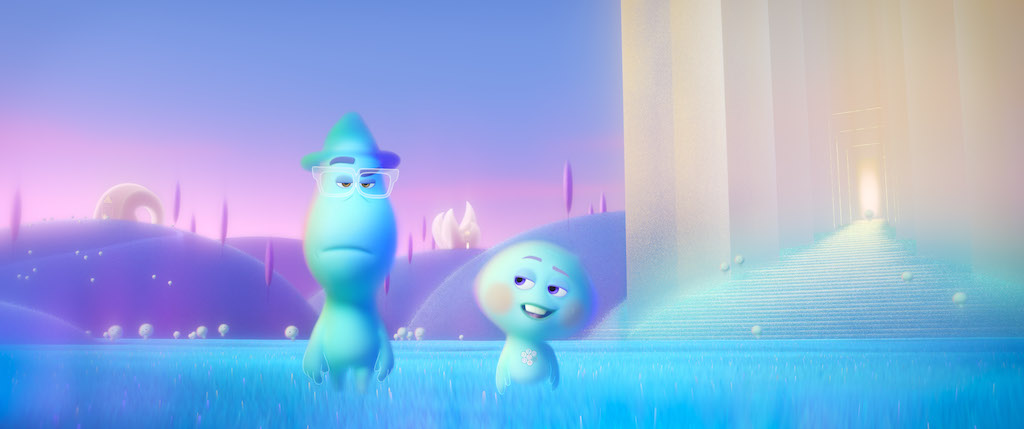
The “soul” referenced in the title of Pixar’s new film is a bit of a double entendre. There’s the soul we talk about when we say, of a musician, “he plays with soul.” And there’s the actual soul—the one that floats up into the afterlife. And maybe it’s just me—but I wish Soul had stuck to the first definition and ditched the second. Not because the film isn’t engaging from beginning to end—it is. But because my favorite part was the earth-bound stuff, which featured one of the most evocative renderings of New York City I’ve ever seen on film, animated or not.
If there’s one thing I don’t love about Pixar, it’s that it can be a little gimmicky. It doesn’t always trust us enough to love the human (or anthropomorphic) stories it sets out to tell, so it junks up the works with aliens or alternate universes. I vastly preferred, for example, the beginning of WALL-E in the junkyard to the space antics that followed. And there’s a reason that the most memorable and beloved part of Up is the first 10 minutes that tells an achingly human love story.
Here, we meet aspiring jazz musician Joe (Jamie Foxx, great as usual), who teaches mostly bored high school kids by day and dreams of becoming the next Oscar Peterson by night. The first day we meet him, he gets what seems to be his big break—a chance to gig with famous jazz chanteuse Dorothea (Angela Bassett). He’s so overjoyed that, as he skips away from the successful audition, he falls into a manhole.
“Oh no,” I thought.
Those first few minutes of the film are filled with colorful depictions of New York street life—cabs and pizza gleaming with oil and bustling crowds of people bumping into each other. The colors inside the lamp-lit nightclub where Joe hopes to perform are all warm caramels and burgundies. The music pops off the stage—we see Joe’s reverie when he gets lost in a jazz passage; his version of an out-of-body experience. The children in Joe’s class wear beanies and backpacks and some have their hair in twists or dreads. It’s not just urban life—it’s Black urban life, which we rarely see depicted so vividly in animated films.
And then everything gets washed out in the afterlife. Joe loses his character and becomes this glowy, orby thing (still amusingly in a porkpie hat and glasses). Everything around him is stripped of earthly specificity. I have a theory about this: Pixar believes that children—especially young children—can’t comprehend, let alone appreciate, the textures and details of their complex cityscapes. From Teletubbies to Minions, children tend to like creatures that are one-dimensional, cute, and easy to digest. So Pixar gives the grownups the gift of a fully realized New York City, then shifts to an afterlife of simple colors and shapes for the little ones who want to watch movies again and again and again.
Which is not to say the afterlife depicted here isn’t clever—it is. Joe is supposed to go straight to what seems to be heaven, but he jumps out of line, tumbles down a long staircase, and ends up in a limbo of sorts, where former humans become mentors to soon-to-be humans. He is assigned a particularly vexing case, 22 (Tina Fey), who has no interest in becoming a person. She doesn’t get what all the fuss is about and no matter how much great music, food, literature, or science you expose her to, she’s indifferent. (Of course, she can’t actually experience those things, because she doesn’t quite exist yet—but she can be told about them.)
I was relieved, however, when 22 and Joe land back on earth, although not quite how Joe pictured it (I won’t spoil the purr-fect mix-up). Then, the great afterlife Bean Counter—a surrealist figure who can shapeshift into anything on earth—is extremely upset by Joe’s breach of protocol and follows them, intent on bringing Joe back to where he apparently belongs.
Back on terra firma, everything I love about the film is restored, particularly its grudgingly affectionate view of New York. The film understands what all New Yorkers intrinsically get—that loving and hating the city are two sides of the same coin. So there are jokes about the Knicks being awful, the filth of the New York subway, and how hard it is for a Black man to hail a cab. Heck, pizza rat even makes a cameo. There are also scenes that show the city in all of its ineffable beauty. One shot of the famous Silvercup sign from the Queensboro Bridge took my breath away.
Of course, Joe’s stint in the afterlife will teach him enduring life lessons—about what’s really important on this earth and how to appreciate all those messy details that make life worth living. I maintain he could’ve learned those things via an earthly story. Either way, the film’s got soul.
Soul is available starting Christmas Day on Disney Plus.
